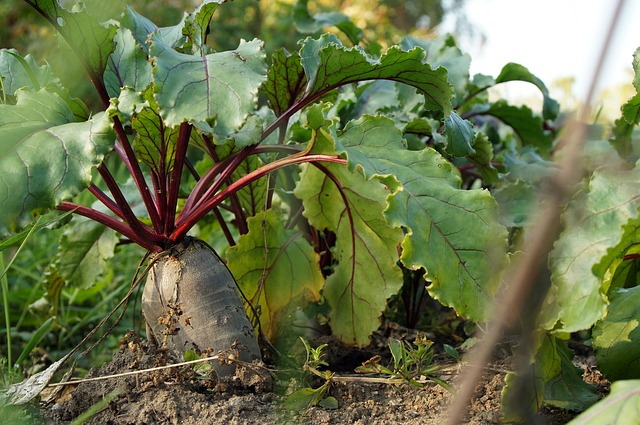You can Juice BeetRoot Leaves
Every time you buy beet and throw leaves out, you are making a big mistake. The beet is usually used on the menu in the preparation of vegetables and salads. However, the leaves end up being neglected or discarded. Often we discard most of vegetables and fruits because we believe that its bark, seeds, and leaves have no utility. It is a big mistake, and it is possible to use these elements to create new spices and give our recipes a different flavor, besides collaborating with nature reducing food waste. But can you juice beetroot leaves? Of course you can, actually, you should because the beet leaves are colorful and a great addition to your green juice.
Sweet and juicy, the part of the beet that we consume the most is its root where are many concentrated nutrients. But its leaves are also very nutritious and should be considered for soups and salads. Be the salad, baked, boiled, mixed with a classic or prepared soup and juice – like Olympic athletes do.
The benefits of beet for health are numerous. It is low in fat, vitamins and minerals filled and charged with powerful antioxidants.
The benefits include detoxification beet skin, preventing liver injury, increased production of red blood cells and strengthening the immune system.
However, a crucial part of this plant is usually discarded consumption: the leaves. They are rich in minerals such as iron, phosphorus, and potassium and bring significant benefits to the health of the body.
BeetRoot leaves Benefits
The beet leaves and stems are rich in minerals such as iron, calcium and phosphorus. Moreover it has vitamin A, which has antioxidant action and prevents the onset of unwanted wrinkles. Beet leaves, as well as the bulb of the vegetable are full of nutrients, that are good for health and are even linked to cancer prevention.
Low in calories: 100 grams of leaves contains 32 calories. The leaves can be used to prepare salads, bread, soups or stews and tastes similar to spinach. Counting with vitamins A, C, and B complex, high iron content, beet leaves act to combat anemia and has a diuretic and laxative effect. Thanks to the natural carotenoid pigment presence, the leaves also help protect against the aging vision.
Combat Anemia: It is not now that we know the qualities of beets in combating anemia, but the beet leaves are also potent in the extreme. The leaves have a rich source of iron; helps anemic overcome this disease that affects the production of red blood cells. Beet tea is also ideal for minimizing the symptoms of anemia, such as dizziness and fatigue. Furthermore, the substance produced tubers with that provides a good circulation of oxygen in the body, which facilitates a deeper sleep and decreases restlessness.
Prevents Cancer: Other important properties of the beet leaf, which remains in tea made with vegetables, are betacyanin and nitrosamine. These substances are responsible for inhibiting cancer cells in the body and reducing the metabolism which develops cancer, affecting the colon, breast and skin.
Lesser Heart Problems: The sheets are substances called carotenoids and flavonoids which act as antioxidants that reduce bad cholesterol (LDL) and enhance the generation of good cholesterol (HDL). These principles assist in dilation of blood vessels, causing a greater quantity of oxygen to the body, lowering blood pressure.
Liver Functions Better: Alcohol consumption or lack of protein intake which form fats in the body, those that are harmful to health. The beet leaf has called betaine and methionine properties, which help eliminate these fats.
Improved digestion: Also regarding the fibers, beet leaf helps digestion and improves bowel movement. The sheet is also important in the activation of nerves of the intestines and controls the amount of acid in the stomach.
The Skin’s friend: With its antioxidant power, beet leaves scavenges free radicals, thus being beneficial to the skin. Moreover, it purifies the blood and making the skin glow. The tea this beet green is helpful against boils and pimples, reduces inflammation in the skin, acts as anti-aging and helps maintain skin elasticity by protecting it from solar radiation.
Warning: Don’t forget that beet leaves should be consumed moderately, since a lot of oxalates in its composition. Excessive consumption can favor the formation of kidney stones.
How can you juice beetroot leaves? Follow the instructions
- Wash the beet greens in cold water and soak for at least five minutes to remove all the earth. Since you will not cook them, the leaves should be as clean as possible.
- Tear or cut the sheets into smaller pieces. Place the leaves (you can make beet bulb juice also if desired) in the juicer and turn on the device. Depending on the type, you may need to use a higher speed to extract the juice. Pour into a sealed bag and reserve in the refrigerator.
- If you do not have a juicer, you can use a blender. Place the leaves in a blender, add two tablespoons of water and turn on the device. Liquefy well for at least one minute. When ready, strain the juice to remove the substantial parts.
- Mix various juices and ingredients to make the tastiest beet juice. Pure beet juice, leaves or bulb (either), the body can undergo rapid detoxification which can result in nausea, chills, fever, urticaria and even paralysis of the vocal cords. Therefore, consume beet juice in moderation, mixing it with other juices such as apple, celery or carrot. Never use more than 30 or 60 ml of beetroot juice at a time, and mix it with at least one or two cups of water or another source of juice. Avoid mixing beet juice with other vegetables rich in calcium.
- Add protein powders or oils to increase the health benefits. A tablespoon or two of protein powder, a few drops of fish oil, flax seed oil or cod liver oil will give your juice a power to more and increase the fatty acid content type omega-3.
Home » Health & Fitness »

